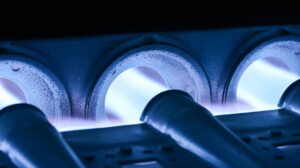Natural gas furnaces are a popular heating system in the United States. About 47% of US homeowners use a natural gas furnace to heat their homes–that’s almost half! Considering that gas furnaces are an efficient method of heating a home, it’s no surprise that they’re so popular for keeping homes comfortable and cozy.
Although gas furnaces are built with safety features to prevent gas leaks, no system is 100% safe. If you make up the 47% of homeowners using a natural gas furnace, it’s important to be aware of things that could go wrong.
A rare issue but a potentially hazardous and lethal one is a cracked heat exchanger. If you own a gas furnace, you need to be aware of the signs of a cracked heat exchanger in your home. That way, you’ll know to call us immediately for furnace repair.
What Is a Heat Exchanger?
Your furnace’s heat exchanger is a metal container that collects hot combustion gas from the burners. The heat from the gas transfers to the metal walls, causing the exchanger to burn hot. Air from the blower moves around the exchanger and picks up the heat before it passes into the ventilation system. The remaining combustion exhaust is sent through a flue to the outside air.
A heat exchanger is prone to wear and tear. Its metal chambers expand and contract as it heats your home. This is why short cycling places so much strain on a furnace. Eventually, the strain and corrosion can cause a crack to form.
This is why cracked heat exchangers are more likely to be found in old, outdated gas furnaces. If a crack develops, the carbon monoxide gas (CO) could potentially leak into your home which is a major safety concern.
What Are the Symptoms of a Cracked Heat Exchanger?
Heat exchanger cracks aren’t usually visible to the naked eye. That’s why you need to know the signs of a cracked heat exchanger.
- Your carbon monoxide detectors are going off
- Someone in your household is experiencing symptoms of carbon monoxide poisoning such as nausea, fatigue, vomiting, and flu-like symptoms
- You can detect unpleasant odors in your home such as the smell of sulfur, formaldehyde, or rotten eggs
- Your furnace isn’t producing heat
- There are exterior cracks or corrosion on the outside of your furnace which indicates there’s also interior corrosion
- You hear a repeated clicking noise after the blower shuts off or other noises such as rattling, popping, and banging
- You can see a buildup of soot
- The pilot light is yellow or orange–it should be blue
The Importance of Furnace Maintenance
It’s important to schedule annual furnace maintenance to avoid this potential safety hazard. Although this is a rare situation that’s more likely to occur in older furnaces, annual maintenance provides an opportunity for our technicians to help avoid this problem or catch it early, no matter how old your gas furnace is.
Contact A-1 Mechanical Heating & Cooling for your next furnace repair. Comfort and Character You Can Depend On!

